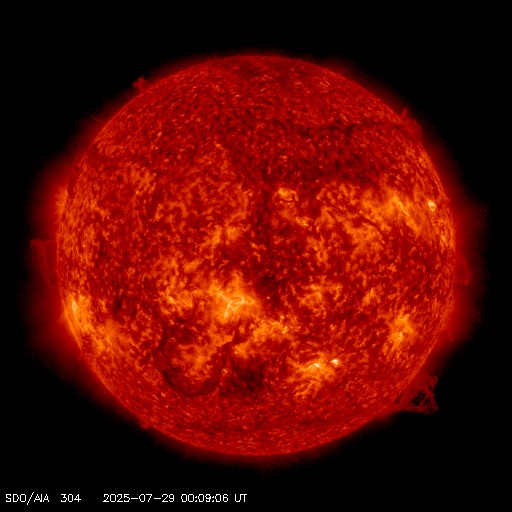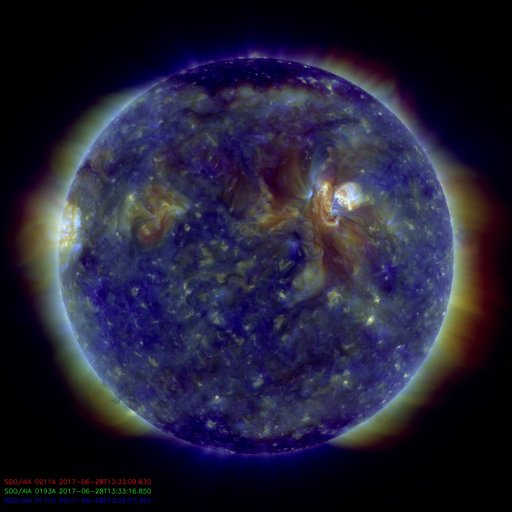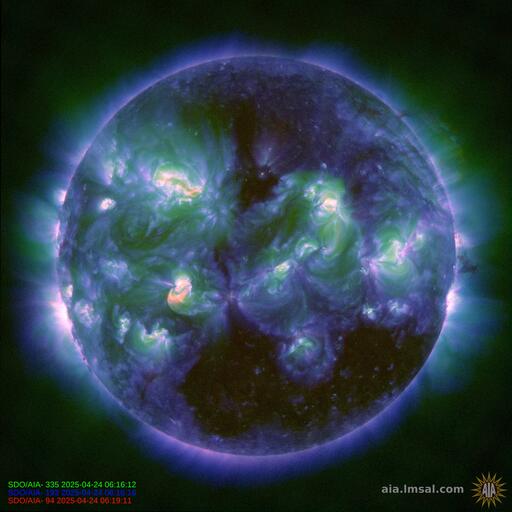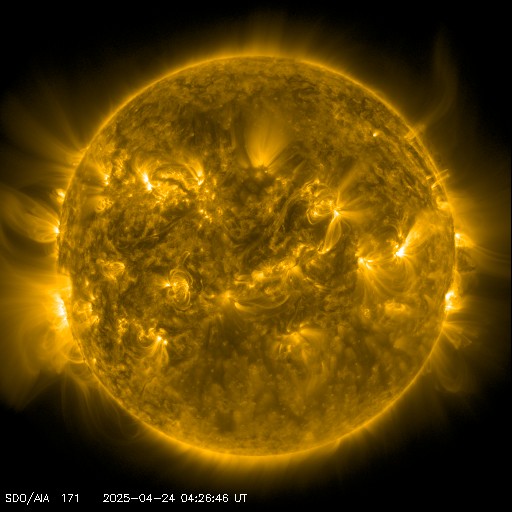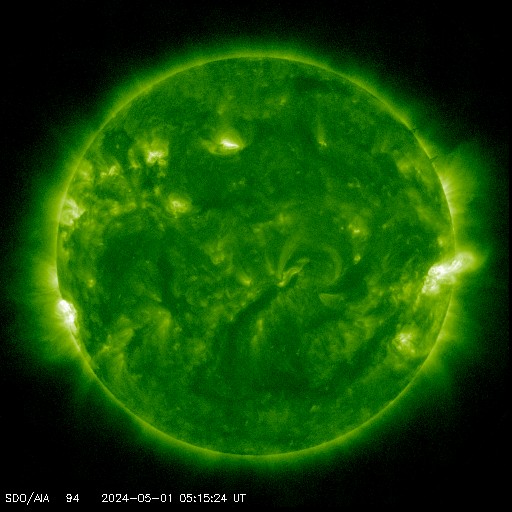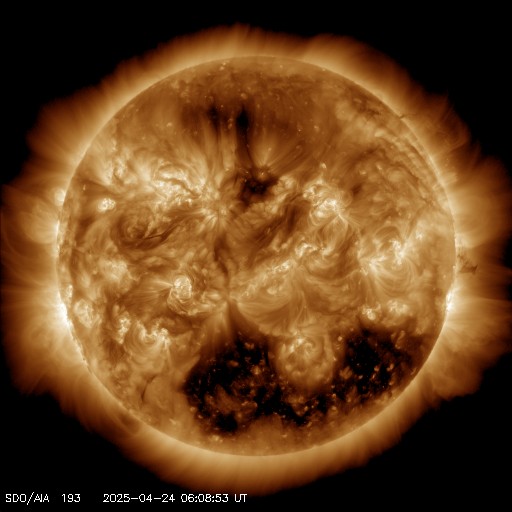On April 23, 2012 at 17:38 UTC, plage Region 1461 (N10W19), produced a C2.0 Solar Flare with an associated Earth directed Full Halo CME. Varying models place the time of arrival for this CME between April 26, at approx 14:00 UTC, according to the NOAA/WSA-ENLIL Model( click this link to see the latest plot : NOAA/WSA-ENLIL CME Model ), to April 27, at 05:49:22 UTC, Confidence Level: ± 6 hours, with the NASA/ISWA CCMC-ENLIL Model. (click this link to see the latest plot:ISWA/CCMC-ENLIL CME Earth Cone Model). On this animated gif (left),we can see the Full Halo CME as it spreads out around the disk in all directions; captured here by SOHO with the LC3 telescope. Although it is hard to see in this image, there is also a Sundiving Comet that can be seen taking its last trip through the solar system, as it dives into the Sun. You can see it travel from the bottom of the movie window up into the disk at the 7:00 position. For a larger high resolution view click on the gif image. For a current view click the "Latest Lasco C3 Movie" box, over on the right hand side of our page!
Solar Alerts Monitoring
Tuesday, April 24, 2012
Earth Directed Full Halo CME
On April 23, 2012 at 17:38 UTC, plage Region 1461 (N10W19), produced a C2.0 Solar Flare with an associated Earth directed Full Halo CME. Varying models place the time of arrival for this CME between April 26, at approx 14:00 UTC, according to the NOAA/WSA-ENLIL Model( click this link to see the latest plot : NOAA/WSA-ENLIL CME Model ), to April 27, at 05:49:22 UTC, Confidence Level: ± 6 hours, with the NASA/ISWA CCMC-ENLIL Model. (click this link to see the latest plot:ISWA/CCMC-ENLIL CME Earth Cone Model). On this animated gif (left),we can see the Full Halo CME as it spreads out around the disk in all directions; captured here by SOHO with the LC3 telescope. Although it is hard to see in this image, there is also a Sundiving Comet that can be seen taking its last trip through the solar system, as it dives into the Sun. You can see it travel from the bottom of the movie window up into the disk at the 7:00 position. For a larger high resolution view click on the gif image. For a current view click the "Latest Lasco C3 Movie" box, over on the right hand side of our page!
Geomagnetic Storm G2 and Mid Latitude Aurora
A Geomagnetic Storm, NOAA Sclae G2 Moderate Kp=6, causing a Mid Latitude Aurora, continues due to the arrival of a CME that lifted off the solar disk on April 19th. Solar wind velocities increased from 350 - 400 km/s. For the original post on the origins of this CME, read the original post here: CME arrival soon and sunspot update . The CME arrived with a Geomagnetic Sudden Impulse that was observed by NOAA at the Boulder CO magnetometer with a deviation of 31 nT at 03:23 UTC on April 23.
Space Weather Message Code: ALTK06
Serial Number: 284
Issue Time: 2012 Apr 24 0047 UTC
ALERT: Geomagnetic K-index of 6
Threshold Reached: 2012 Apr 24 0046 UTC
Synoptic Period: 0000-0300 UTC
Active Warning: Yes
NOAA Scale: G2 - Moderate
Potential Impacts: Area of impact primarily poleward of 55 degrees Geomagnetic Latitude.
Induced Currents - Power grid fluctuations can occur. High-latitude power systems may experience voltage alarms.
Spacecraft - Satellite orientation irregularities may occur; increased drag on low Earth-orbit satellites is possible.
Radio - HF (high frequency) radio propagation can fade at higher latitudes.
Aurora - Aurora may be seen as low as New York to Wisconsin to Washington state.
Friday, April 20, 2012
CME arrival soon and sunspot update
 One new region was numbered overnight; this was region 1464 which is located just to the north of region 1460, and is a BXO type group at 10 millionths in size.
One new region was numbered overnight; this was region 1464 which is located just to the north of region 1460, and is a BXO type group at 10 millionths in size.
Region 1459 decayed in size from a EKC group at 250 millionths, to a DSI at 180 millionths.
Most other groups increased slightly in size.
Numerous C class solar flares took place yesterday, the largest was a
C7 peaking at 1126z from region 1455 that rotated out of view 2 days
ago.
This region produced a large coronal mass ejection that is not Earth directed.
A C1 solar flare from region 1462 also produced a coronal mass ejection that may have an Earthward component. The geomagnetic field is expected to be
quiet to active on April 20.
The CME observed on April 18 could reach
Earth on April 21, and cause active conditions through April 22.
An Aurora watch will be in effect for the next 72 hours.
Here you can link to some Auroral cams:
Thursday, April 19, 2012
Large Filament lift off southeast

Update 23:30 UTC:
The filament lift off we see here on the image to the left was maybe a result of a channel eruption
Right after that filament lift off we could see a rly nice explosion (ejecta) also seen on Stereo Ahead EUVI imagery
http://stereo.gsfc.nasa.gov/browse/2012/04/19/behind_20120419_euvi_195_512.mpg
The CME looks really bright. Due to the location of the source (southwest) a direct hit will be probably unlikely. But a portion of it could strife us
http://stereo.gsfc.nasa.gov/browse/2012/04/19/behind_20120419_cor2_512.mpg
Subscribe to:
Comments (Atom)

